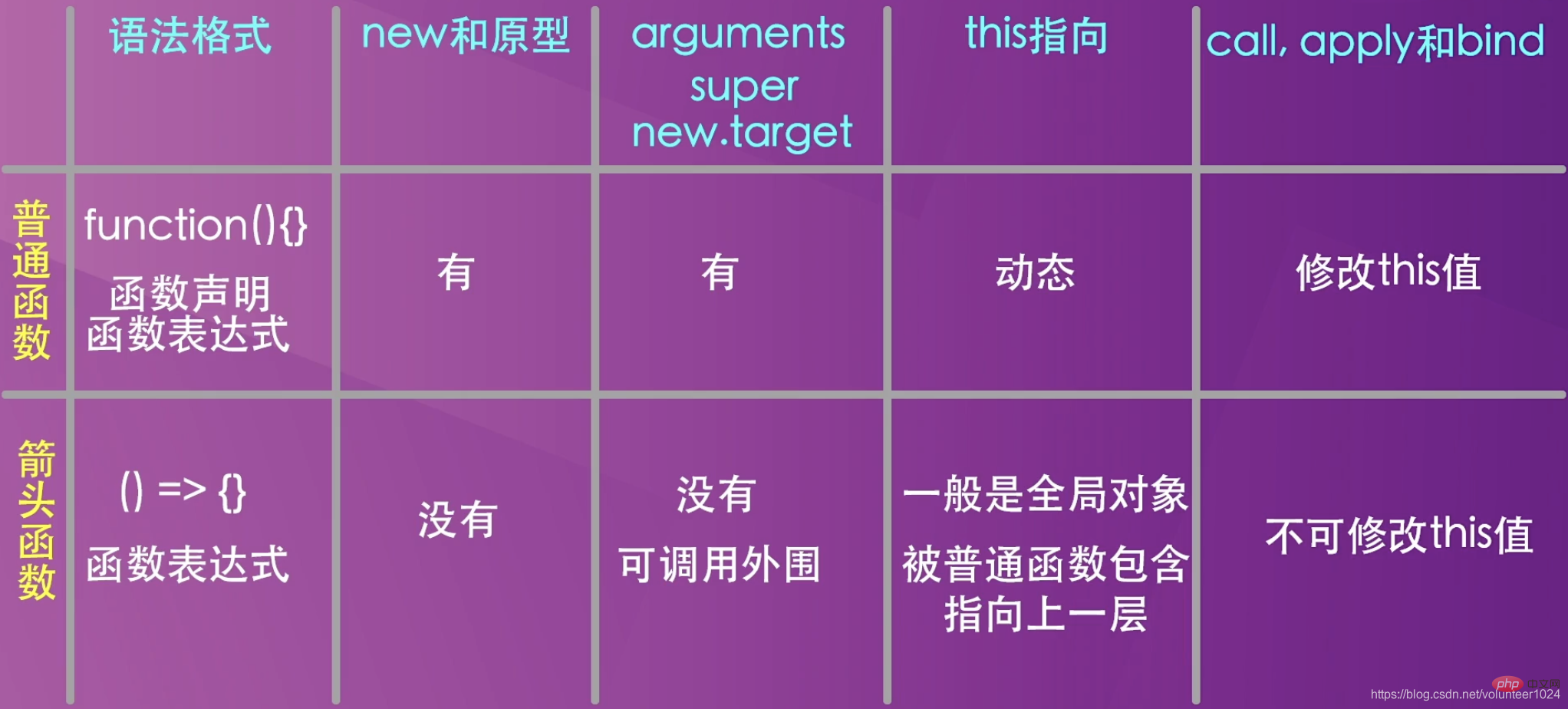ホームページ >ウェブフロントエンド >フロントエンドQ&A >ES6 アロー関数の実践コード例
ES6 アロー関数の実践コード例
- WBOYWBOYWBOYWBOYWBOYWBOYWBOYWBOYWBOYWBOYWBOYWBOYWB転載
- 2022-08-08 10:26:021102ブラウズ
この記事では、javascript に関する関連知識を提供します。主にアロー関数の適用に関する問題を紹介します。アロー関数式は、本来匿名関数が必要な場所に適しており、使用できません。皆さんの参考になれば幸いです。

[関連する推奨事項: JavaScript ビデオ チュートリアル 、Web フロントエンド ]
はじめに
アロー関数式の構文は関数式よりも簡潔であり、独自の this、引数、super または new.target を持ちません。アロー関数式は、匿名関数が必要であり、コンストラクターとして使用できない場合に適しています。 ---- MDN
基本的な使用法
パラメータ表現
(param1, param2, …, paramN) => { statements }
(param1, param2, …, paramN) => expression
//相当于:(param1, param2, …, paramN) =>{ return expression; }
// 当只有一个参数时,圆括号是可选的:
(singleParam) => { statements }
singleParam => { statements }
// 没有参数的函数应该写成一对圆括号。
() => { statements }
戻り値表現
let add1 = (num1, num2) => {
num1 + num2
};
let add2 = (num1, num2) => {
return num1 + num2
};
let add3 = (num1, num2) => (num1 + num2);
let add4 = (num1, num2) => num1 + num2;
console.log(add1(2, 3)); // undefined
console.log(add2(2, 3)); // 5
console.log(add3(2, 3)); // 5
console.log(add4(2, 3)); // 5
高度な
//加括号的函数体返回对象字面量表达式:
let func = () => ({foo: 'bar'})
console.log(func()); // {foo: 'bar'}
//支持剩余参数和默认参数
(param1, param2, ...rest) => { statements }
(param1 = defaultValue1, param2, …, paramN = defaultValueN) => {
statements }
//同样支持参数列表解构
let f = ([a, b] = [1, 2], {x: c} = {x: a + b}) => a + b + c;
f(); // 6
this

ベスト プラクティス
- 匿名関数またはインライン コールバック関数を使用する必要がある場合は、アロー関数を使用してください。 eslint:prefer-arrow-callback, arrow-spacing
why?構文はより簡潔で、これはより期待に沿ったものです
関数のロジックが非常に複雑な場合は、名前付き関数を使用する必要があります。
// bad[1, 2, 3].map(function (x) {
const y = x + 1;
return x * y;});// good[1, 2, 3].map((x) => {
const y = x + 1;
return x * y;});
- 関数本体にステートメントが 1 つしかなく、そのステートメントに副作用がない場合。暗黙的に返すには短縮形式を使用し、明示的に返すには完全形式を使用します。
eslint: arrow-parens, arrow-body-style
// bad
[1, 2, 3].map(number => {
const nextNumber = number + 1;
`A string containing the ${nextNumber}.`;
});
// good
[1, 2, 3].map(number => `A string containing the ${number}.`);
// good
[1, 2, 3].map((number) => {
const nextNumber = number + 1;
return `A string containing the ${nextNumber}.`;
});
// good
[1, 2, 3].map((number, index) => ({
[index]: number,
}));
// No implicit return with side effects
function foo(callback) {
const val = callback();
if (val === true) {
// Do something if callback returns true
}
}
let bool = false;
// bad
foo(() => bool = true);
// good
foo(() => {
bool = true;
});
- 式が複数行を占める場合は、可読性を高めるために括弧を使用してください
why? 関数の始まりと終わりはより明確です
// bad['get', 'post', 'put'].map(httpMethod => Object.prototype.hasOwnProperty.call( httpMagicObjectWithAVeryLongName, httpMethod, ));// good['get', 'post', 'put'].map(httpMethod => ( Object.prototype.hasOwnProperty.call( httpMagicObjectWithAVeryLongName, httpMethod, )));
- 関数にパラメーターが 1 つしかない場合は、括弧と中括弧を省略します。それ以外の場合は、一貫性を維持するために常に完全な書き込み方法を使用してください。 eslint: arrow-parens
// bad[1, 2, 3].map((x) => x * x);// good[1, 2, 3].map(x => x * x);// good[1, 2, 3].map(number => (
`A long string with the ${number}. It’s so long that we don’t want it to take up space on the .map line!`));// bad[1, 2, 3].map(x => {
const y = x + 1;
return x * y;});// good[1, 2, 3].map((x) => {
const y = x + 1;
return x * y;});
- 明確な => 構文を使用して、= と区別します。 eslint: no-confusing-arrow
// badconst itemHeight = item => item.height > 256 ? item.largeSize : item.smallSize;// badconst itemHeight = (item) => item.height > 256 ? item.largeSize : item.smallSize;// goodconst itemHeight = item => (item.height > 256 ? item.largeSize : item.smallSize);// goodconst itemHeight = (item) => {
const { height, largeSize, smallSize } = item;
return height > 256 ? largeSize : smallSize;
簡単な結論
アロー関数は new を使用してコンストラクターのインスタンスを作成できませんが、通常の関数は使用できます。 (アロー関数が作成されるとき、プログラムはそのための構築メソッドを作成しません。つまり、構築能力がなく、使用後に破棄されます。再利用される通常の関数とは異なり、コンストラクター プロトタイプ、つまりプロトタイプ属性は自動的に生成されません)
プログラムはアロー関数の引数オブジェクトを作成しません
これ通常の関数では動的ですが、アロー関数の this は、アロー関数をタイトにラップするオブジェクト (定義時に決定) を指します。
アロー関数は、 this の値を変更することはできません。 bind、call、apply は実行できますが、これらのメソッドを呼び出すことはできます (this の値がこれらのメソッドによって制御されないだけです)
[関連する推奨事項: javascript ビデオ チュートリアル、ウェブ フロントエンド]
以上がES6 アロー関数の実践コード例の詳細内容です。詳細については、PHP 中国語 Web サイトの他の関連記事を参照してください。

